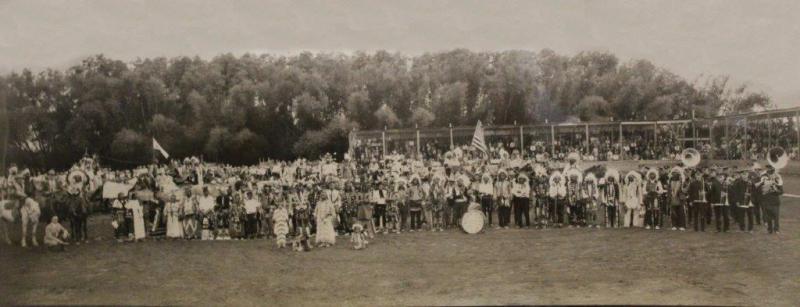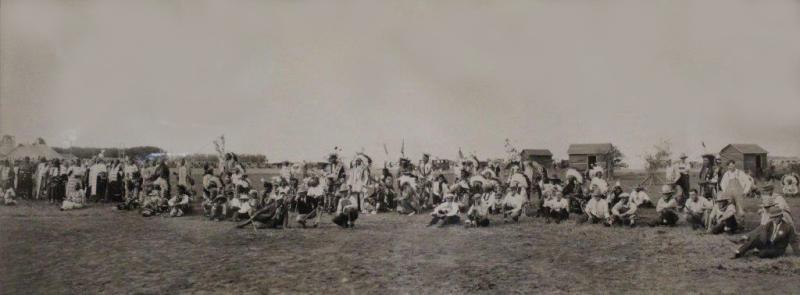
Sioux Indian Pow-Wow Was Fully Up To Publicity Claim September 11-12, 1928
The weatherman seemed to be against the Indian Pow-Wow put on by the American Legion Tuesday and Wednesday. The special train bearing the 200 Sioux Indians from Chamberlain, S.D., arrived about 8:30 Monday morning in a downpour of rain. the Legion boys took the Indians immediately to the Legion Hall where they served them with breakfast. Later in the forenoon the sun came out and they were able to make camp on the Knicker farm north of town, where the program was held.
Many drove out Monday afternoon and evening to view the camp, which afforded a very picturesque appearance with the tents and tepees set up in true Indian camp style. Beeves had been butchered by the Indians during the day and one could see the meat hanging on the lines in Indian fashion in the evening. Indians of all ages came with the tribe. Some were very old and some were little papooses. The latter were especially interesting, with their bright eyes and brilliant costumes.
The program Tuesday morning started with the parade, which was led by the famous Hartley Municipal Band. The band was followed by the Indians in full regalia and paint. Their costumes were very gorgeous and of many colors and their faces were dyed many different hues, a deep yellow seeming to be the favorite color with the squaws, while some of the bucks had their faces painted a deep red or purple. A number of the men rode horseback in the parade, while some walked. The squaws and children rode in democrat wagons, which is the most common mode of transportation among the Indians. The squaws sat in the bottom of the wagons with their papooses on their laps or by their sides. the parade passed the school house and supt. Johnson very thoughtfully caused the fire alarm to sounded at this time, giving the children an opportunity to see without causing any confusion in the different classrooms.
Following the ball game, a grand parade was the first feature of the program at the camp grounds. This followed much the same order as the street parade.
An Indian expert lariat roper, Chancy Fire, gave a very interesting demonstration of his ability as a roper. he was really an artist in his line, keeping the rope in an almost complete circle and constantly moving without allowing it to touch the ground, until the rope resembled a live snake in its movements.
The Indian pony race was very interesting and was enjoyed by the four Indians--Begolia Johnson, Isaac Crow, Al Dismounts and George Shields--who staged the race, as well as by the audience. the winner of the race was presented with and Indian blanker.
The Indian tepee race was one of the most novel features of the afternoon. Two Indian squaws taking part in this race rode in the back of democrat wagons driven by their husbands. In the wagons they had the poles and covering for building a tepee. The race was to see which could drive around the race track and have her tepee set up and completed in the shortest space of time. this was very educational, showing how first the three main poles were tied together and set up in position, forming the main foundation of the tepee. Other poles were then added between these, two forming the foundation of the opening used as a doorway. The covering was then place in position and securely fastened to the ground with stakes. The squaws were very swift in their movements and both finished the race at almost the same instant. Both were presented with Indian blankets as prizes.
The pony relay race showed the natural skill and swiftness of the Indian in riding and changing saddles. The idea of this race was to race around the track and then after each time around change horses by changing the saddle to a new horse. This was won by George Shields.
The keg roping contest created much amusement. Several kegs were set in a row on the ground and the Indians, mounted on ponies, rode past the kegs, trying to lasso them with their ropes. The one who carried the keg with the rope the greatest distance won the contest. the Indians taking part in this were Chancy Fire, the winner, and Isaac Crow, George Shields, Eagle Tail and M. Turtle.
The Indians taking part in the Indian chair race enjoyed it very much and were droll in attempting to play tricks on each other, which shows that an Indian has a sense of humor after all. Isaac Crow was the winner. Others taking part were George Shields, Bill Ross, Dan Quilt and Chancy Fire. In this race the riders rode off across the field and at a signal turned their horses and rode as fast as possible toward the kegs, which evidently are called Indian chairs. It was very comical to see two or three Indians trying to be seated on the same keg at the same time.
After these contests came the part that everyone seemed to be waiting for--the depiction of the Spirit Lake massacre of 1862, when several white settlers were killed and others were taken captive by the Indians. They first held a pow-wow and war dance while making plans to make the raid on the white settlement. Several cabins had been constructed on the field to represent the original settlement at Spirit Lake. During the pow-wow the white settlers were working in their fields and cutting wood. The parts of the white settlers were taken by Gay Hesse, Hobart Putnam, Darwin Putnam, Warren Huston and Dick Lage. After the war dance and pow-wow, two Indian scouts were sent to the settlement to beg for food. They later returned and shot one of the white men (Gay Hesse). The Indian battle which followed was very realistic when the Indians made a rush on the settlement. The Indians proved themselves good actors by feigning death when hit by the bullets of the settlers. Several of the white men were killed and some escaped. One man (Darwin Putnam) was taken captive by the Indians and taken to camp. However, the most realistic part of the battle was the firing of the cabins, which were soon burned. When the captive was taken to camp another pow-wow was held, in which it decided to kill him.
The closing feature of the program was the slaughtering of a beef, which was done in true Indian style.
The Wednesday program was carried out in much the same order as that of Tuesday.
We are requested by the Legion post to extend thanks to the business men and those in general who gave such whole hearted support in the effort to make the Pow-Wow a success and to assure all that their support is fully appreciated.



